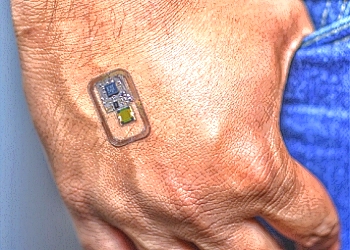Researchers at RMIT University in Australia and the University of Arizona in the United States have developed a battery-free, wearable device that monitors people’s exposure to nicotine in real time, reports the American Chemical Society.
Some studies have shown that nicotine, an addictive substance in electronic cigarettes, increases the risk of cardiovascular and respiratory disorders. But to get a full understanding of its potential health effects, a real-time nicotine monitoring device is needed.
Such a device could also help vapers – as well as non-vapers who encounter second-hand smoke – measure their exposure, reported the American Chemical Society (ACS) on 8 December 2021.
Now, researchers report in the journal ACS Sensors that they have developed a battery-free, wearable device that could accomplish this task.
E-cigarettes are designed to heat and aerosolise a mixture of nicotine, glycerine, propylene glycol and flavouring additives, which the user then inhales. In the body, this mixture can affect multiple organs, including the respiratory system, where it may alter airflow, increases oxidative stress and impairs immunity. In addition, nicotine exposure may lead to lung cancer.
But assessing that exposure under real world conditions has been difficult. Current assays for measuring ambient nicotine levels are carried out in laboratory settings and require large sample volumes and days to weeks of sampling.
Portable nicotine sensors are being developed as an alternative, but the two that have been reported are impractical because they rely either on the presence of sweat or sunlight to function.
So Dr Madhu Bhaskaran, Ataur Rahman and Philipp Gutruf set out to design a lightweight, wearable sensor capable of detecting nicotine in real time and sending the data wirelessly to electronic devices such as a smartphone.
The team chose vanadium dioxide (VO2) on a polyimide substrate as the basis for their sensor. They showed that nicotine can bond covalently to a thin film of VO2, thereby altering the film's conductivity to an extent that depends on nicotine concentration.
The device detects the change in conductivity, amplifies the signal and then transmits it wirelessly to a smartphone.
When applied to skin, the battery-free sensor can measure the wearer's exposure to vapourised nicotine in open air. The researchers say this approach expands the use of wearable electronics for real-time monitoring of hazardous substances in the environment.
* The authors acknowledge funding from the Australian Research Council.
Study details
Nicotine Sensors for Wearable Battery-Free Monitoring of Vaping
Ataur Rahman, Le Cai, Sherif Abdulkader Tawfik, Stuart Tucker, Alex Burton, Ganganath Perera, Michelle JS Spencer, Sumeet Walia, Sharath Sriram, Philipp Gutruf and Madhu Bhaskaran
Published in ACS Sensors on 8 December 2021.
Abstract
Nicotine, an addictive substance in tobacco products and electronic cigarettes (e-cigs), is recognised for increasing the risk of cardiovascular and respiratory disorders. Careful real-time monitoring of nicotine exposure is critical in alleviating the potential health impacts of not just smokers but also those exposed to second-hand and third-hand smoke.
Monitoring of nicotine requires suitable sensing material to detect nicotine selectively and testing under free-living conditions in the standard environment. Here, we experimentally demonstrate a vanadium dioxide (VO2)-based nicotine sensor and explain its conductometric mechanisms with compositional analysis and density functional theory (DFT) calculations.
For real-time monitoring of nicotine vapor from e-cigarettes in the air, the sensor is integrated with an epidermal near-field communication (NFC) interface that enables battery-free operation and data transmission to smart electronic devices to record and store sensor data.
Collectively, the technique of sensor development and integration expands the use of wearable electronics for real-time monitoring of hazardous elements in the environment and biosignals wirelessly.
See also from the MedicalBrief archives
New Zealand, United States ponder cutting nicotine levels in cigarettes
When quitting cigarettes, consider using more nicotine, not less
E-cigarettes using nicotine cause blood clotting and impair small blood vessels
In world first, NHS may prescribe e-cigarettes for smoking cessation

